Related Research Articles
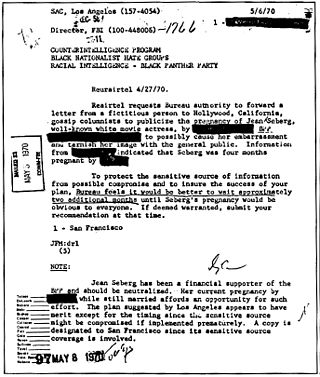
COINTELPRO was a series of covert and illegal projects actively conducted by the United States Federal Bureau of Investigation (FBI) aimed at surveilling, infiltrating, discrediting, and disrupting domestic American political organizations. FBI records show COINTELPRO resources targeted groups and individuals the FBI deemed subversive, including feminist organizations, the Communist Party USA, anti–Vietnam War organizers, activists of the civil rights and Black power movements, environmentalist and animal rights organizations, the American Indian Movement (AIM), Chicano and Mexican-American groups like the Brown Berets and the United Farm Workers, independence movements, a variety of organizations that were part of the broader New Left, and white supremacist groups such as the Ku Klux Klan and the far-right group National States' Rights Party.

The Federal Bureau of Investigation (FBI) is the domestic intelligence and security service of the United States and its principal federal law enforcement agency. Operating under the jurisdiction of the United States Department of Justice, the FBI is also a member of the U.S. Intelligence Community and reports to both the Attorney General and the Director of National Intelligence. A leading U.S. counterterrorism, counterintelligence, and criminal investigative organization, the FBI has jurisdiction over violations of more than 200 categories of federal crimes.

Fulgencio Batista y Zaldívar was a Cuban military officer and politician who served as the elected president of Cuba from 1940 to 1944 and as a military dictator from 1952 to 1959, until he was overthrown in the Cuban Revolution.

Secret police are police, intelligence, or security agencies that engage in covert operations against a government's political, religious, or social opponents and dissidents. Secret police organizations are characteristic of authoritarian and totalitarian regimes. They protect the political power of a dictator or regime and often operate outside the law to repress dissidents and weaken political opposition, frequently using violence. They may enjoy legal sanction to hold and charge suspects without ever identifying their organization.
In the United States, a special agent is an official term used to refer to an investigator or detective for a federal or state government or independent agency, who primarily serves in criminal investigatory positions. Additionally, many federal and state special agents operate in "criminal intelligence" based roles as well. Within the U.S. federal law enforcement system, dozens of federal agencies employ federal law enforcement officers, each with different criteria pertaining to the use of the titles Special Agent and Agent. These titles are also used by many state level agencies to refer to their personnel.

In the United States, a Joint Terrorism Task Forces (JTTF) is a locally-based multi-agency partnership between various federal, state, and local law enforcement agencies tasked with investigating terrorism and terrorism-related crimes, led by the Federal Bureau of Investigation and U.S. Department of Justice. The first JTTFs were established before the September 11 attacks, with their numbers increasing dramatically in the years after.

The First Main Directorateof the Committee for State Security under the USSR council of ministers was the organization responsible for foreign operations and intelligence activities by providing for the training and management of covert agents, intelligence collection administration, and the acquisition of foreign and domestic political, scientific and technical intelligence for the Soviet Union. The First Chief Directorate was formed within the KGB directorate in 1954, and after the collapse of the Soviet Union became the Foreign Intelligence Service. The primary foreign intelligence service in Russia and the Soviet Union has been the GRU, a military intelligence organization and special operations force.

The Bureau of Diplomatic Security, commonly known as Diplomatic Security (DS), is the security branch of the United States Department of State. It conducts international investigations, threat analysis, cyber security, counterterrorism, and protection of people, property, and information. Its mission is to provide a safe and secure environment for officials to execute the foreign policy of the United States.
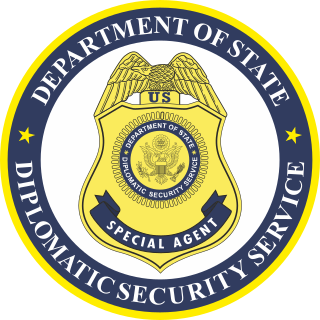
The Diplomatic Security Service (DSS) is the principal security and law enforcement agency of the United States Department of State (DOS). As the operational division of DOS' Bureau of Diplomatic Security, its primary mission is to protect diplomatic assets, personnel, and information and combat visa and passport fraud. DSS also conducts counterterrorism, counterintelligence, cybersecurity and criminal investigations domestically and abroad.

The Ministry of State Security is the principal civilian intelligence, security and secret police agency of the People's Republic of China, responsible for foreign intelligence, counterintelligence, and political security of the Chinese Communist Party. One of the largest and most secretive intelligence organizations in the world, it is headquartered in the Haidian District of Beijing, with powerful semi-autonomous branches at the provincial, city, municipality and township levels throughout China.
Maurice Hyman Halperin (1906–1995) was an American writer, professor, diplomat, and accused Soviet spy.
Amerasia was a journal of Far Eastern affairs best known for the 1940s "Amerasia Affair" in which several of its staff and their contacts were suspected of espionage and charged with unauthorized possession of government documents.

The National Security Branch (NSB) is a service within the Federal Bureau of Investigation. The NSB is responsible for protecting the United States from weapons of mass destruction, acts of terrorism, and foreign intelligence operations and espionage. The NSB accomplishes its mission by investigating national security threats, providing information and analysis to other law enforcement agencies, and developing capabilities to keep the US nation secure.
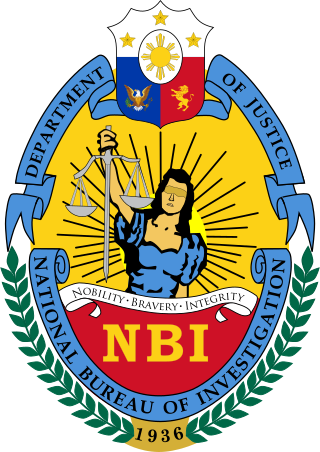
The National Bureau of Investigation is an agency of the Philippine government under the Department of Justice, responsible for handling and solving major high-profile cases that are in the interest of the nation.
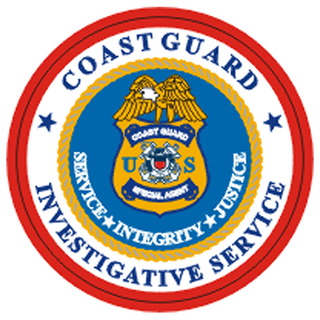
The Coast Guard Investigative Service (CGIS) is a division of the United States Coast Guard that investigates crimes where the U.S. Coast Guard has an interest. It is composed of civilian (GS-1811), active duty, reserve enlisted, and warrant officer special agents.

The Counter Intelligence Corps was a World War II and early Cold War intelligence agency within the United States Army consisting of highly trained special agents. Its role was taken over by the U.S. Army Intelligence Corps in 1961 and, in 1967, by the United States Army Intelligence Agency. Its functions are now performed by its modern-day descendant organization, United States Army Counterintelligence. The National Counter Intelligence Corps Association (NCICA), a veterans' association, was established in the years immediately following World War II by former military intelligence agents.
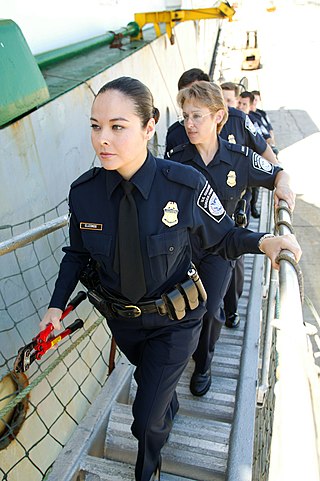
The federal government of the United States empowers a wide range of federal law enforcement agencies to maintain law and public order related to matters affecting the country as a whole.
Project Gunrunner is a project of the U.S. Bureau of Alcohol, Tobacco, Firearms and Explosives (ATF) intended to stem the flow of firearms into Mexico, in an attempt to deprive the Mexican drug cartels of weapons.
Ricardo Morales Navarette, also known by the moniker "El Mono", was a Cuban exile and agent of the United States Central Intelligence Agency. He also worked for the DISIP, or Venezuelan intelligence service, and as an informant for the US Federal Bureau of Investigation, Central Intelligence Agency, and Drug Enforcement Administration.
References
- ↑ Selden, Zachary (2022). "Special Intelligence Service of the Federal Bureau of Investigation: Forgotten Forerunner of the Central Intelligence Agency". International Journal of Intelligence and CounterIntelligence: 1–18. doi:10.1080/08850607.2022.2113988. ISSN 0885-0607. S2CID 252339789.
- ↑ Anderson, Susan Heller. "Jerome Doyle, 79, Noted Lawyer Who Became a Public Defender". The New York Times, January 1, 1989: D27.
- ↑ "A Look Back: A Small Office with a Big Mission". fbi.gov. Retrieved December 30, 2016.
- ↑ "Archived copy". Archived from the original on 2016-12-25. Retrieved 2016-07-28.
{{cite web}}: CS1 maint: archived copy as title (link) - ↑ "Federal Bureau of Investigation". Search results. Various years. (accessed January 29, 2013).
- ↑ United States. Department of Justice. Federal Bureau of Investigation. Special Intelligence Service. Annual Report 1944-1945. Federal Bureau of Investigation, p. 27.
- ↑ United States. Department of Justice. Federal Bureau of Investigation. Special Intelligence Service. Annual Report 1944-1945. Federal Bureau of Investigation, p. 28.
- ↑ United States. Department of Justice. Federal Bureau of Investigation. Special Intelligence Service. Annual Report 1944-1945. Federal Bureau of Investigation, p. 33
- ↑ United States. Department of Justice. Federal Bureau of Investigation. Special Intelligence Service. Annual Report 1944-1945. Federal Bureau of Investigation, p. 29
- ↑ United States. Department of Justice. Federal Bureau of Investigation. Special Intelligence Service. Annual Report 1944-1945. Federal Bureau of Investigation, pp. 80-82.
- ↑ United States. Department of Justice. Federal Bureau of Investigation. Special Intelligence Service. "Personnel Record, Jeremiah Cordes Delworth." File 67-226505. Stephen D. Calhoun, 1941-1945.
- ↑ United States. Department of the Air Force. Air Force Historical Research Agency. "Microfilm Roll 46556." Maxwell Air Force Base, AL: Stephen D. Calhoun, 1945.
- ↑ Buenos Aires UP. "Lost U.S. Plane Found in Argentina; 14 Dead." The New York Times, December 8, 1945: 9.
- ↑ Buenos Aires AP. "14 Air Victims to Be Cremated." The New York Times, December 12, 1945: 19.
- ↑ United States. Department of Justice. Federal Bureau of Investigation. Special Intelligence Service. Annual Report 1944-1945. Federal Bureau of Investigation, p. 39
- ↑ FBI personnel file 67-129997, Robert Howard Calhoun
- ↑ United States. Department of Justice. Federal Bureau of Investigation. Special Intelligence Service. Annual Report 1944-1945. Federal Bureau of Investigation, p. 36-37
- ↑ Ramonas, Andrew (March 30, 2010). "DOJ Creates Human Rights And Special Prosecutions Section". MainJustice.com. Archived from the original on October 22, 2010. Retrieved July 6, 2010.
